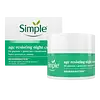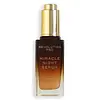Simple Skincare Regeneration Age Resisting Night Cream Versus Revolution Beauty Pro Miracle Night Rescue Serum Advanced Complex
What's inside
What's inside
 Key Ingredients
Key Ingredients

 Benefits
Benefits

 Concerns
Concerns

 Ingredients Side-by-side
Ingredients Side-by-side

Water
Skin ConditioningC12-15 Alkyl Benzoate
AntimicrobialBehenyl Behenate
EmollientGlycerin
HumectantSqualane
EmollientButylene Glycol
HumectantCetyl Palmitate
EmollientPolyhydroxystearic Acid
EmulsifyingPolyglyceryl-10 Stearate
Skin ConditioningPanthenol
Skin ConditioningDimethicone
EmollientPhenoxyethanol
PreservativeCarbomer
Emulsion StabilisingEuphorbia Cerifera Cera
AstringentSodium Stearoyl Lactylate
EmulsifyingTocopheryl Acetate
AntioxidantSodium Hydroxide
BufferingEthylhexylglycerin
Skin ConditioningPentylene Glycol
Skin ConditioningSerine
MaskingSodium Lactate
BufferingLactic Acid
BufferingUrea
BufferingFomes Officinalis Extract
Skin ProtectingSorbitol
HumectantPantolactone
HumectantPEG-40 Hydrogenated Castor Oil
EmulsifyingBisabolol
MaskingBorago Officinalis Seed Oil
EmollientSodium Chloride
MaskingPropylene Glycol
HumectantAllantoin
Skin ConditioningCamellia Sinensis Leaf Extract
AntimicrobialWater, C12-15 Alkyl Benzoate, Behenyl Behenate, Glycerin, Squalane, Butylene Glycol, Cetyl Palmitate, Polyhydroxystearic Acid, Polyglyceryl-10 Stearate, Panthenol, Dimethicone, Phenoxyethanol, Carbomer, Euphorbia Cerifera Cera, Sodium Stearoyl Lactylate, Tocopheryl Acetate, Sodium Hydroxide, Ethylhexylglycerin, Pentylene Glycol, Serine, Sodium Lactate, Lactic Acid, Urea, Fomes Officinalis Extract, Sorbitol, Pantolactone, PEG-40 Hydrogenated Castor Oil, Bisabolol, Borago Officinalis Seed Oil, Sodium Chloride, Propylene Glycol, Allantoin, Camellia Sinensis Leaf Extract
Water
Skin ConditioningBis-PEG-18 Methyl Ether Dimethyl Silane
EmollientLactobacillus Ferment Lysate
Skin ConditioningBifida Ferment Lysate
Skin ConditioningPropanediol
SolventPEG-8 Caprylic/Capric Glycerides
EmulsifyingBetaine
HumectantGlycereth-26
HumectantMethyl Gluceth-10
EmulsifyingPhenoxyethanol
PreservativeGlycerin
HumectantCarbomer
Emulsion StabilisingCaffeine
Skin ConditioningPropylene Glycol
HumectantYeast Extract
Skin ConditioningSodium Hydroxide
BufferingEthylhexylglycerin
Skin ConditioningDisodium EDTA
Simmondsia Chinensis Seed Oil
EmollientSqualane
EmollientLavandula Angustifolia Oil
MaskingBisabolol
MaskingSodium Hyaluronate
HumectantAdansonia Digitata Fruit Extract
EmollientChamomilla Recutita Flower Extract
MaskingLactic Acid
BufferingCentella Asiatica Leaf Extract
Skin ConditioningLeuconostoc/Radish Root Ferment Filtrate
AntimicrobialSodium Benzoate
MaskingSodium Chloride
MaskingPotassium Sorbate
PreservativeAcetic Acid
BufferingRosa Centifolia Flower Extract
AstringentCeramide NP
Skin Conditioning2,3-Butanediol
HumectantCaprylyl Glycol
EmollientBis(Tripeptide-1) Copper Acetate
Skin ConditioningHydrogenated Lecithin
EmulsifyingSorbic Acid
PreservativeGlyceryl Stearate
EmollientCeramide AP
Skin ConditioningCeramide As
Skin ConditioningCeramide Ns
Skin ConditioningCholesterol
EmollientSodium Metabisulfite
AntioxidantCeramide EOP
Skin ConditioningFarnesol
PerfumingCitronellol
PerfumingGeraniol
PerfumingLinalool
PerfumingCI 15985
Cosmetic ColorantCI 19140
Cosmetic ColorantCI 17200
Cosmetic ColorantWater, Bis-PEG-18 Methyl Ether Dimethyl Silane, Lactobacillus Ferment Lysate, Bifida Ferment Lysate, Propanediol, PEG-8 Caprylic/Capric Glycerides, Betaine, Glycereth-26, Methyl Gluceth-10, Phenoxyethanol, Glycerin, Carbomer, Caffeine, Propylene Glycol, Yeast Extract, Sodium Hydroxide, Ethylhexylglycerin, Disodium EDTA, Simmondsia Chinensis Seed Oil, Squalane, Lavandula Angustifolia Oil, Bisabolol, Sodium Hyaluronate, Adansonia Digitata Fruit Extract, Chamomilla Recutita Flower Extract, Lactic Acid, Centella Asiatica Leaf Extract, Leuconostoc/Radish Root Ferment Filtrate, Sodium Benzoate, Sodium Chloride, Potassium Sorbate, Acetic Acid, Rosa Centifolia Flower Extract, Ceramide NP, 2,3-Butanediol, Caprylyl Glycol, Bis(Tripeptide-1) Copper Acetate, Hydrogenated Lecithin, Sorbic Acid, Glyceryl Stearate, Ceramide AP, Ceramide As, Ceramide Ns, Cholesterol, Sodium Metabisulfite, Ceramide EOP, Farnesol, Citronellol, Geraniol, Linalool, CI 15985, CI 19140, CI 17200
 Reviews
Reviews

Ingredients Explained
These ingredients are found in both products.
Ingredients higher up in an ingredient list are typically present in a larger amount.
Bisabolol is famous for its skin soothing properties. It does this by blocking inflammatory signals, helping to reduce your body's reaction to irritation.
This ingredient also interferes with the process of hyperpigmentation. This can help with reducing dark spots and uneven tone.
Bisabolol is an antioxidant. Antioxidants help fight free-radicals. Free-radicals are molecules that may damage your skin cells. By fighting these free-radicals, Bisabolol may slow down signs of aging.
Studies have shown Bisabolol to have antimicrobial properties and may be a fungicide. These properties help preserve a product's shelf life.
All these properties makes bisabolol a great skin barrier helper ingredient.
Bisabolol also helps the absorption of other ingredients.
Note: Synthetic Bisabolol has been shown to be less effective.
Learn more about BisabololCarbomer is a polymer of acrylic acid. Its main role is to create a gel consistency.
A high amount of carbomer can cause pilling or balling up of products. Don't worry, most products contain 1% or less of carbomer.
Ethylhexylglycerin (we can't pronounce this either) is commonly used as a preservative and skin softener. It is derived from glyceryl.
You might see Ethylhexylglycerin often paired with other preservatives such as phenoxyethanol. Ethylhexylglycerin has been found to increase the effectiveness of these other preservatives.
Glycerin is already naturally found in your skin. It helps moisturize and protect your skin.
A study from 2016 found glycerin to be more effective as a humectant than AHAs and hyaluronic acid.
As a humectant, it helps the skin stay hydrated by pulling moisture to your skin. The low molecular weight of glycerin allows it to pull moisture into the deeper layers of your skin.
Hydrated skin improves your skin barrier; Your skin barrier helps protect against irritants and bacteria.
Glycerin has also been found to have antimicrobial and antiviral properties. Due to these properties, glycerin is often used in wound and burn treatments.
In cosmetics, glycerin is usually derived from plants such as soybean or palm. However, it can also be sourced from animals, such as tallow or animal fat.
This ingredient is organic, colorless, odorless, and non-toxic.
Glycerin is the name for this ingredient in American English. British English uses Glycerol/Glycerine.
Learn more about GlycerinLactic Acid is another well-loved alpha hydroxy acid (AHA). It is gentler than glycolic acid but still highly effective.
Its main role is to exfoliate the surface of the skin by loosening the “glue” that holds dead skin cells together. Shedding those old cells leads to smoother, softer, and more even-toned skin.
Because lactic acid molecules are larger than glycolic acid, they don’t penetrate as deeply. This means they’re less likely to sting or irritate, making it a great choice for beginners or those with sensitive skin.
Like glycolic acid, it can:
Lactic acid also acts as a humectant (like hyaluronic acid). It can draw water into the skin to improve hydration and also plays a role in the skin's natural moisturizing factor (NMF) in the form of sodium lactate.
Studies show it can boost ceramide production to strengthen the skin barrier and even help balance the skin’s microbiome.
To get results, choose products with a pH between 3-4.
Lower strengths (5-12%) focus on surface exfoliation; higher strengths (12% and up) can reach deeper in the dermis (deeper, supportive layer) to improve skin texture and firmness over time.
Though it was originally derived from milk, most modern lactic acid used in skincare is vegan. It is made through non-dairy fermentation to create a bio-identical and stable form suitable for all formulations.
When lactic acid shows up near the end of an ingredient list, it usually means the brand added just a tiny amount to adjust the product’s pH.
Legend has it that Cleopatra used to bathe in sour milk to help reduce wrinkles.
Lactic acid is truly a gentle multitasker: it exfoliates, hydrates, strengthens, and brightens. It's a great ingredient for giving your skin a smooth, glowing, and healthy look without the harshness of stronger acids.
Read more about some other popular AHA's here:
Learn more about Lactic AcidPhenoxyethanol is a preservative that has germicide, antimicrobial, and aromatic properties. Studies show that phenoxyethanol can prevent microbial growth. By itself, it has a scent that is similar to that of a rose.
It's often used in formulations along with Caprylyl Glycol to preserve the shelf life of products.
Propylene Glycol is an odorless, colorless liquid. As a humectant, it helps skin retain moisture. It also aids in delivering active ingredients.
Another role of this ingredient is preventing a product from melting or freezing. Propylene glycol also adds antimicrobrial properties to a product, elongating product lifespan.
This ingredient is considered an organic alcohol and commonly added into both cosmetics and foods.
Those with sensitive skin or conditions may develop a rash when using this ingredient.
Learn more about Propylene GlycolChances are, you eat sodium chloride every day. Sodium Chloride is also known as table salt.
This ingredient has many purposes in skincare: thickener, emulsifier, and exfoliator.
You'll most likely find this ingredient in cleansers where it is used to create a gel-like texture. As an emulsifier, it also prevents ingredients from separating.
There is much debate on whether this ingredient is comedogenic. The short answer - comedogenic ratings don't tell the whole story. Learn more about comegodenic ratings here.
The concensus about this ingredient causing acne seems to be divided. Research is needed to understand if this ingredient does cause acne.
Scrubs may use salt as the primary exfoliating ingredient.
Learn more about Sodium ChlorideSodium Hydroxide is also known as lye or caustic soda. It is used to adjust the pH of products; many ingredients require a specific pH to be effective.
In small amounts, sodium hydroxide is considered safe to use. However, large amounts may cause chemical burns due to its high alkaline.
Your skin has a natural pH and acid mantle. This acid mantle helps prevent harmful bacteria from breaking through. The acid mantle also helps keep your skin hydrated.
"Alkaline" refers to a high pH level. A low pH level would be considered acidic.
Learn more about Sodium HydroxideSqualane is an emollient that helps the skin hold onto moisture. It's an oily liquid that occurs naturally in certain types of fish and plant oils.
Because squalane boosts hydration in the skin, it also comes with plenty of benefits: it is an antioxidant and can help fight free radicals and skin damage. Squalane is also found to have a detoxifying effect when applied.
Squalane comes from squalene, which occurs naturally within the sebum of our skin. It is one of the oils our skin produces to keep itself hydrated. Squalane is the hydrogenated version of squalene and has a longer shelf life.
Research shows that squalane is non-irritating (even at 100% concentration).
In general, it's a fantastic ingredient. It does a great job at hydrating the skin, and it's suitable for those with sensitive skin.
The source of squalane may impact malassezia / fungal acne. This is because olive oil derived squalane can contain impurities such as fatty acids and plant waxes. Sugarcane derived squalane is recommended for anyone with malassezia concerns.
Is squalane vegan?
This depends on the source. Squalane can be derived from both plants and animals. Most squalane used in skincare comes from plants.
Please note: the source of squalane is only known if disclosed by the brand. We recommend reaching out to the brand if you have any questions about their squalane.
Read more about squalene with an "e".
Is squalane an oil?
Squalane is often called an oil, but it’s technically not; it’s a hydrocarbon, meaning it’s only made of carbon and hydrogen, unlike true oils which are triglycerides made of fatty acids and glycerol.
The term “oil-free” isn’t regulated, so companies can define it however they want. Some exclude all oils, while others just avoid mineral oil or comedogenic oils.
While some people avoid oils thinking they cause breakouts, the right kind of oil (or oil-like ingredient like squalane) can actually help balance and hydrate your skin. It’s worth testing out simple oils or squalane to see what works best for your skin.
Learn more about SqualaneWater. It's the most common cosmetic ingredient of all. You'll usually see it at the top of ingredient lists, meaning that it makes up the largest part of the product.
So why is it so popular? Water most often acts as a solvent - this means that it helps dissolve other ingredients into the formulation.
You'll also recognize water as that liquid we all need to stay alive. If you see this, drink a glass of water. Stay hydrated!
Learn more about Water